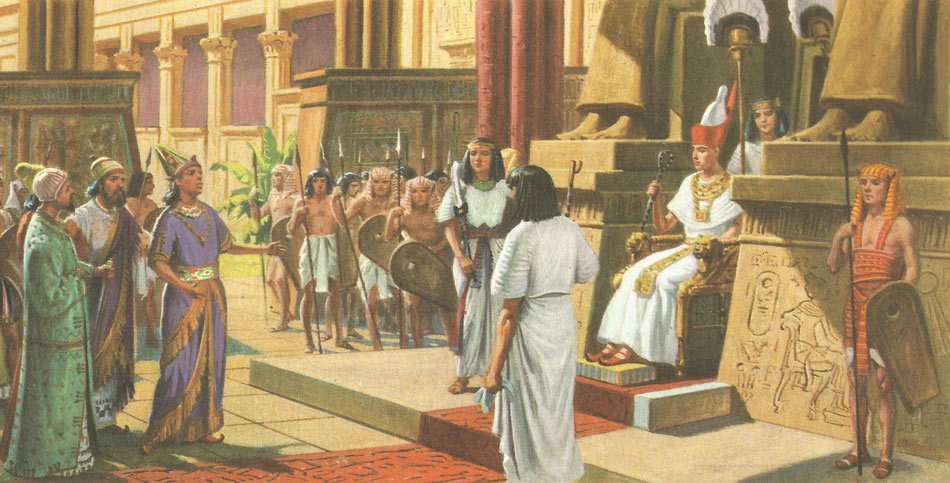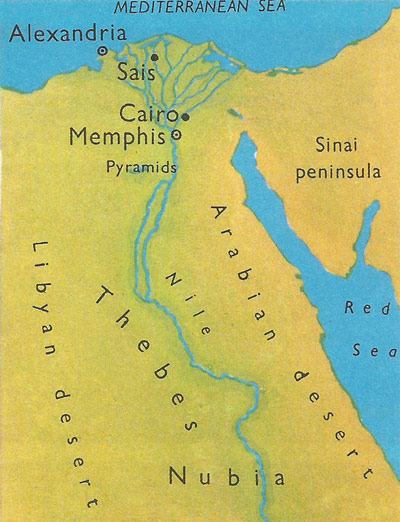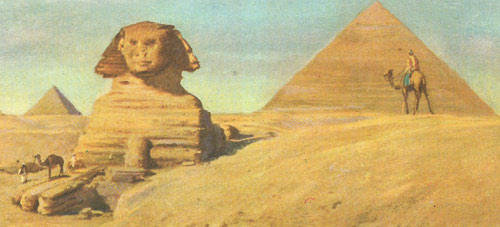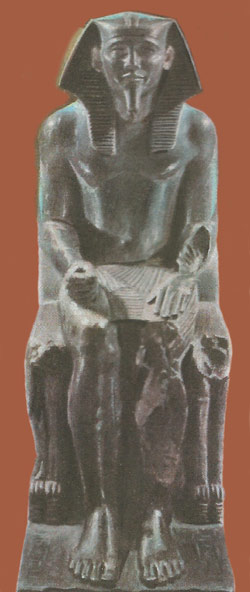Ancient Egypt

Rameses II receives a Hittite delegation in his audience hall. The negotiations put an end to a struggle which had lasted for 16 years.

Map of ancient Egypt.

The colossal Sphinx built in the reign of the Pharaoh Chephren in the third millennium BC.
Three thousand years before the birth of Christ there was a flourishing civilisation in Egypt. This country, with frontiers that were almost impenetrable, retained highly organised monarchy and system of government for a staggering length of time. From about 3100 BC until 525 BC, when it was finally annexed by Persia, Egypt was ruled by succeeding generations of Pharaohs belonging to no fewer than 26 reigning families or dynasties. Egypt provided a cultural center of art, architecture, and literature at a time when virtually all the rest of the world's inhabitants lived lives of primitive savages; and the other Near-Eastern civilizations which did arise were overthrown long before they had produced anything like the achievements of Ancient Egypt. The Ancient Egyptians lived in an atmosphere of permanence; the ever-flowing Nile, the ageless Pyramids, and the inscrutable Sphinx perhaps impressed the people of the time as much as they do ourselves. There desert boundaries to the east and west, their sea to the north, and backward Nubia (the modern Sudan) to the south, kept Egypt, on the whole secure from invasions, and with this feeling of security, daily life remained in some ways virtually unchanged over 2,000 years.
The Old Kingdom (3100–2200 BC)
The history of Ancient Egypt falls into three main periods: The old Kingdom, the Middle Kingdom, and the New Kingdom. It was about 5,000 years ago that the tribes living alongside the great river Nile united under one leader. He was the first Pharaoh, named Menes. Records of Menes are non-existent, though there is evidence that he was the same man as the Pharaoh Namer, and early ruler of the Old Kingdom, about whom a certain amount is known. But whatever obscurity and doubt there is about origin of the monarchy, there can be no doubt as to the benefits it brought. The whole Egyptian economy was centered on the Nile, and its fertile plains brought a rich and regular harvest. The people anxiously watched it as a measure of their seasonal fortunes. As Shakespeare put it:
'The higher Nilus swells
The more it promises: as it ebbs the seedsman
Upon the slime and ooze scatters his grain
And shortly comes to harvest.'
But to bring the benefits of the Nile to a large area required immense irrigation projects involving the building of dams, canals, and ditches. The tribes had to pool their resources for such tasks, and Menes became the first Egyptian Pharaoh. He built Memphis, the first capitol of united Egypt, and so began a unique chapter in the history of progress.
The period of the Old Kingdom, which spanned the first six dynasties, was a time of peace and prosperity. Trade was developed with Egypt's neighbors; from the north she received timber and certain metals, while from the south came luxuries like ostrich feathers, ebony, ivory, and incense for use in religious rituals. Above all, the Old Kingdom saw colossal monuments rise out of Egyptians and, and in the Fourth Dynasty the Pharaohs Cheops, Chephren, and Mycerinus built the three magnificent pyramids on the Giza plain. Chephren also built the Sphinx, probably the most famous 'statue' ever erected.
 |
| Statue of the Pharaoh Chephren
|
The Middle Kingdom (2150–1780 BC)
By the close of the Sixth Dynasty power was beginning to pass from the king to some of his local officials and administrators. A period of chaos ensued, and it was not until the 11th Dynasty, when Mentuhopte, the ruler of Thebes, made himself Pharaoh in about 2150 BC, that stability was restored. The capitol of Egypt was now Thebes, and a program of military conquest was started with the annexation of Nubia in the south. Yet the Middle Kingdom was also a period of economic expansion, and it was during the reign of Ammenemesill (1842–1797 BC) that the great artificial lake of Moeris was constructed as a reservoir for the waters of the Nile. But once more the Egyptian monarchy went into decline. From its decline emerged the rule of a mysterious nomadic people from Asia, the Hyksos. They had established themselves not by conquest, but by gradual infiltration, and it was 200 years before they were driven out in 1575 BC by the Pharaoh Ahmose I.
The New Kingdom (1575–1200 BC)
The New Kingdom begins with the expulsion of the Hyksos. This set the tone for the whole period, which was to be stamped with military success. It was the great era of expansion. Palestine and Syria were conquered, and under warlike Thutmosis III (1496-1442 BC) an Empire was built up whose frontiers reached the Euphrates.
The conquered areas were administered rather than settled, and the subject peoples were left much to themselves as long as they paid their regular contributions to the treasury of the Egyptian government. But those vast frontiers did not last long. By 1300 BC the Hittites, and aggressive people from Asia Minor, had driven the Egyptians well back towards their old boundaries. The famous Pharaoh Rameses II reigned between 1299 and 1233 BC, and in 1295 he launched a full-scale attack on the Hittites. For 16 years war raged inconclusively until both countries agreed to a peace treaty, and vowed to maintain 'peace' and eternal 'brotherhood' forever.
The late Period (1200–525 BC)
The final decline of Ancient Egypt began in the so-called Late Period. Egyptian civilisation had remained static while her neighbors had advanced and were at last able to topple her from her pre-eminence. Like the fall of the Roman Empire centuries later, the prelude to the collapse was invasion by warriors from many different regions.
In about 730 BC the Nubians conquered the country, to be followed between 671 BC and 665 BC by the Assyrians under their great leaders Essarhaddon and Assurbanipal. The capital of Egypt was moved to Sais, but nothing could stem the tide. In 525 BC the Persians overran the country, and Egypt's independent history was ended. In 332 BC Alexander the Great incorporated Egypt into his monster Empire, and in 30 BC Egypt became part of the Roman Empire.
Religion in Ancient Egypt
The Ancient Egyptians were preoccupied with the thought of an after-life, which somehow connected with a state of changelessness in the material world. They were used to permanence. Dead bodies do not disintegrate where they fall in the Egyptian sand – they dry up or desiccate. There is in the British Museum today the body – not the skeleton – of an Egyptian born 5,500 years ago. When they began to use coffins they mummified dead bodies to retain the preservation achieved naturally by desiccation. Egyptian mummies of all periods have been found intact.
The gigantic pyramids were simply tombs for the Pharaohs, but built to last forever. Treasures of great value were buried with the mummified body, which lay in a wooden coffin. Egyptians thought their after-life happiness depended on the preservation of their bodies and possessions in the material world.
The colossal Sphinx built in the reign of the Pharaoh Chephren in the third millennium BC